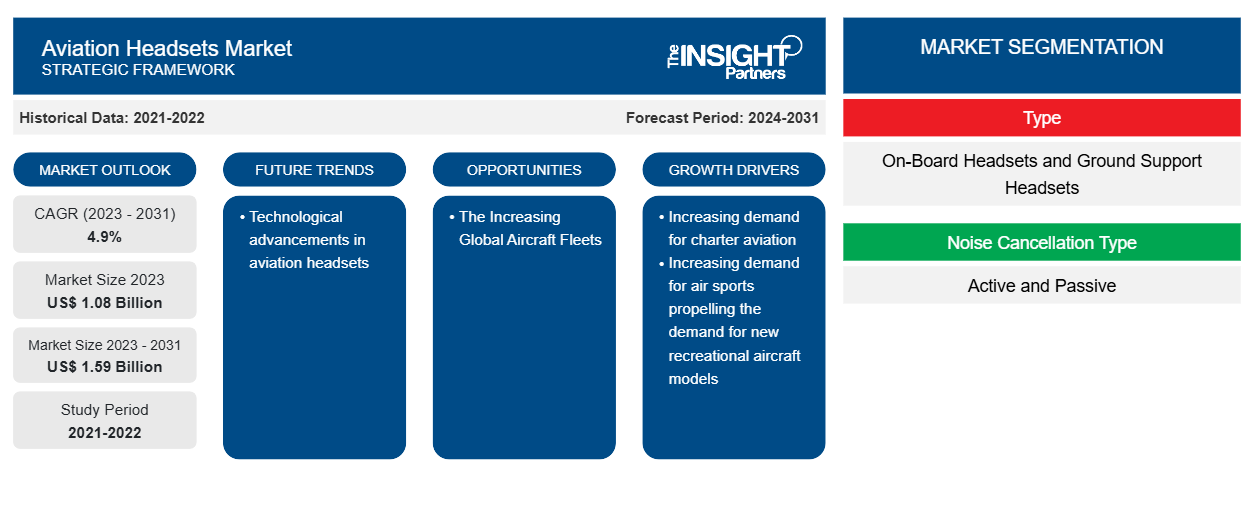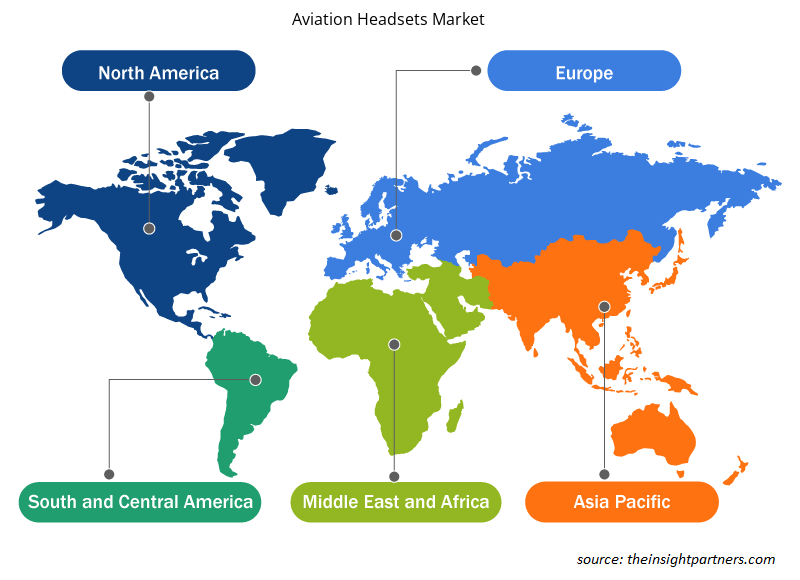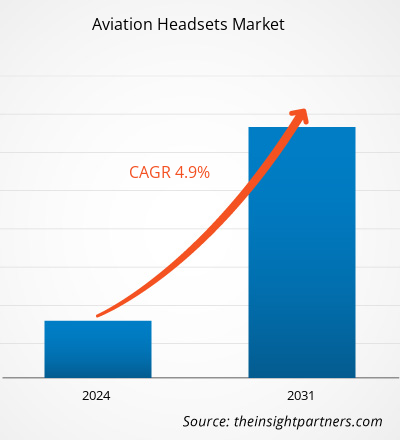The aviation headsets market size is projected to reach US$ 1.59 billion by 2031 from US$ 1.08 billion in 2023. The market is expected to register a CAGR of 4.9% during 2023–2031. Technological advancements in aviation headsets is likely to remain a key trend in the market.
Aviation Headsets Market Analysis
The aviation headsets market ecosystem is diverse and evolving. Its stakeholders are component providers, headset manufacturers, and distributors & end-users. Major players occupy places in the various nodes of the market ecosystem. The component provider’s supply different components such as semiconductor products/chipsets, microphones, speaker components to aviation headset manufacturers who then utilize it to manufacture and design the final aviation headset products. The final product is then distributed to the end users through different mediums such as direct sales through company distributors across the aviation sector.
Aviation Headsets Market Overview
Companies such as Bosch Security & Safety Systems, Bose Corporation, David Clark Company, Lightspeed Aviation, GBH Headsets, Pilot Communications, Plantronics Inc., SEHT Limited, and Sennheiser Electronic GmbH & Co. Kg, are amongst the leading manufacturers in the aviation headsets market. These companies are engaged in design, manufacturing, and selling of wide range of aircraft headsets to end-users such as airlines, MRO companies, aviation OEMs, and defense forces respectively.
Customize This Report To Suit Your Requirement
You will get customization on any report - free of charge - including parts of this report, or country-level analysis, Excel Data pack, as well as avail great offers and discounts for start-ups & universities
Aviation Headsets Market: Strategic Insights

- Get Top Key Market Trends of this report.This FREE sample will include data analysis, ranging from market trends to estimates and forecasts.
You will get customization on any report - free of charge - including parts of this report, or country-level analysis, Excel Data pack, as well as avail great offers and discounts for start-ups & universities
Aviation Headsets Market: Strategic Insights

- Get Top Key Market Trends of this report.This FREE sample will include data analysis, ranging from market trends to estimates and forecasts.
Aviation Headsets Market Drivers and Opportunities
Increasing Demand for Air Sports Propelling the Demand for New Recreational Aircraft Models
The rising number of light-sport aircraft deliveries owing to an increase in awareness for air sports among youngsters across is aiding the deployment of new generation recreational aircraft models. For instance, the rising fleet of existing LSA (light-sport aircraft) is generating the demand for new pilots and headset accessories worldwide. Moreover, the demand for LSA is mainly driven by the rising interest in recreational activities such as sky diving is paving way for new players to establish business while the existing players expanding their business by setting up a new base and buying new aircraft. Therefore, the growing fleet of light-sport aircraft worldwide is aiding the adoption of aviation headsets globally.
The Increasing Global Aircraft Fleets
As per The Insight Partners’ secondary research the global commercial aircraft fleet in 2022 was around 25,578 aircraft that is further likely to reach around 28,398 aircraft by the end of 2024 and around 36,413 aircraft by the end of 2034. Moreover, according to the forecasts disclosed by two of the major aircraft OEMs i.e., Boeing and Airbus, more than 40,800 aircraft are expected to be delivered by the end of 2042 which will further generate the demand for new pilots and headsets in the coming years.
Aviation Headsets Market Report Segmentation Analysis
Key segments that contributed to the derivation of the aviation headsets market analysis are type noise cancellation type, and application.
- Based on type, the aviation headsets market is segmented into on-board headsets and ground support headsets. The on-board headsets segment held a larger market share in 2023.
- Based on noise cancellation type, the aviation headsets market is segmented into active and passive. The active segment held a larger market share in 2023.
- Based on application, the aviation headsets market is segmented into commercial aircraft, military aircraft, and general aviation. The commercial segment held a larger market share in 2023.
Aviation Headsets Market Share Analysis by Geography
The geographic scope of the aviation headsets market report is mainly divided into five regions: North America, Europe, Asia Pacific, Middle East & Africa, and South America.
North America has dominated the market in 2023 followed by Europe and Asia Pacific regions. Further, Asia Pacific is also likely to witness highest CAGR in the coming years. This is mainly due to the expected deliveries of more than 18,800 new commercial aircraft across the region in the next two decades. Further, the rising number of airports across the Asia Pacific region is also pushing the deployment of more number of airplanes in the region which is further likely to generate new opportunities for market vendors in the coming years.
Aviation Headsets Market Regional Insights
The regional trends and factors influencing the Aviation Headsets Market throughout the forecast period have been thoroughly explained by the analysts at Insight Partners. This section also discusses Aviation Headsets Market segments and geography across North America, Europe, Asia Pacific, Middle East and Africa, and South and Central America.

- Get the Regional Specific Data for Aviation Headsets Market
Aviation Headsets Market Report Scope
| Report Attribute | Details |
|---|---|
| Market size in 2023 | US$ 1.08 Billion |
| Market Size by 2031 | US$ 1.59 Billion |
| Global CAGR (2023 - 2031) | 4.9% |
| Historical Data | 2021-2022 |
| Forecast period | 2024-2031 |
| Segments Covered |
By Type
|
| Regions and Countries Covered | North America
|
| Market leaders and key company profiles |
Aviation Headsets Market Players Density: Understanding Its Impact on Business Dynamics
The Aviation Headsets Market is growing rapidly, driven by increasing end-user demand due to factors such as evolving consumer preferences, technological advancements, and greater awareness of the product's benefits. As demand rises, businesses are expanding their offerings, innovating to meet consumer needs, and capitalizing on emerging trends, which further fuels market growth.
Market players density refers to the distribution of firms or companies operating within a particular market or industry. It indicates how many competitors (market players) are present in a given market space relative to its size or total market value.
Major Companies operating in the Aviation Headsets Market are:
- Bosch Security and Safety Systems
- Bose Corporation
- David Clark Company
- Faro Aviation
- GBH Headsets
Disclaimer: The companies listed above are not ranked in any particular order.

- Get the Aviation Headsets Market top key players overview
Aviation Headsets Market News and Recent Developments
The aviation headsets market is evaluated by gathering qualitative and quantitative data post primary and secondary research, which includes important corporate publications, association data, and databases. A few of the developments in the aviation headsets market are listed below:
- Bose, the leader in premium aviation headset technology, today announced its latest innovation: the new A30 Aviation Headset. Unveiled at the SUN ‘n FUN Aerospace Expo in Lakeland, Fla., the A30 is an entirely new product, designed to bring pilots the best combination of comfort, noise cancellation and audio clarity of any aviation headset on the market. (Source: Bose, Press Release, Mar 2023)
Lightspeed Aviation today introduced the Lightspeed Delta Zulu – the first in the next generation of ANR headsets. This revolutionary ANR aviation headset introduces a suite of new features and heralds a new category of aviation product dubbed “Safety Wearables”. (Source: Lightspeed Aviation, Press Release, Sep 2022)
Aviation Headsets Market Report Coverage and Deliverables
The “Aviation Headsets Market Size and Forecast (2021–2031)” report provides a detailed analysis of the market covering below areas:
- Aviation headsets market size and forecast at global, regional, and country levels for all the key market segments covered under the scope
- Aviation headsets market trends as well as market dynamics such as drivers, restraints, and key opportunities
- Detailed porter’s five forces analysis
- Aviation headsets market analysis covering key market trends, global and regional framework, major players, regulations, and recent market developments
- Industry landscape and competition analysis covering market concentration, heat map analysis, prominent players, and recent developments for the aviation headsets market
- Detailed company profiles
Frequently Asked Questions
Which region dominated the aviation headsets market in 2023?
North America region dominated the aviation headsets market in 2023.
What are the driving factors impacting the aviation headsets market?
Increasing demand for charter aviation and increasing demand for air sports propelling the demand for new recreational aircraft models are some of the factors driving the growth for aviation headsets market.
What are the future trends of the aviation headsets market?
Technological advancements in aviation headsets in airfield ground lighting solutions is one of the major trends of the market.
Which are the leading players operating in the aviation headsets market?
Bosch Security and Safety Systems, Bose Corporation, David Clark Company, Faro Aviation, GBH Headsets, Lightspeed Aviation, Pilot Communications, Plantronics Inc, SEHT LIMITED, Sennheiser Electronic GmbH and Co KG, MicroAvionics, Aerotion Aviation, and Radial Avcomm LLC are some of the key players profiled under the report.
What would be the estimated value of the aviation headsets market by 2031?
The estimated value of the aviation headsets market by 2031 would be around US$ 1.59 billion.
What is the expected CAGR of the aviation headsets market?
The aviation headsets market is likely to register of 4.9% during 2023-2031.
- Historical Analysis (2 Years), Base Year, Forecast (7 Years) with CAGR
- PEST and SWOT Analysis
- Market Size Value / Volume - Global, Regional, Country
- Industry and Competitive Landscape
- Excel Dataset
- Aircraft MRO Market
- Helicopter Hoists Winches and Hooks Market
- Fixed-Base Operator Market
- Aerospace Fasteners Market
- Aerospace Stainless Steel And Superalloy Fasteners Market
- Aircraft Floor Panel Market
- Military Optronics Surveillance and Sighting Systems Market
- Smoke Grenade Market
- Airport Runway FOD Detection Systems Market
- Artillery Systems Market
Testimonials
I wish to appreciate your support and the professionalism you displayed in the course of attending to my request for information regarding to infectious disease IVD market in Nigeria. I appreciate your patience, your guidance, and the fact that you were willing to offer a discount, which eventually made it possible for us to close a deal. I look forward to engaging The Insight Partners in the future, all thanks to the impression you have created in me as a result of this first encounter.
DR CHIJIOKE ONYIA, MANAGING DIRECTOR, PineCrest Healthcare Ltd.The Insight Partners delivered insightful, well-structured market research with strong domain expertise. Their team was professional and responsive throughout. The user-friendly website made accessing industry reports seamless. We highly recommend them for reliable, high-quality research services
Yukihiko Adachi CEO, Deep Blue, LLC.Reason to Buy
- Informed Decision-Making
- Understanding Market Dynamics
- Competitive Analysis
- Customer Insights
- Market Forecasts
- Risk Mitigation
- Strategic Planning
- Investment Justification
- Identifying Emerging Markets
- Enhancing Marketing Strategies
- Boosting Operational Efficiency
- Tracking Industry Innovations
- Aligning with Regulatory Trends
Yes! We provide a free sample of the report, which includes Report Scope (Table of Contents), report structure, and selected insights to help you assess the value of the full report. Please click on the "Download Sample" button or contact us to receive your copy.
Absolutely — analyst assistance is part of the package. You can connect with our analyst post-purchase to clarify report insights, methodology or discuss how the findings apply to your business needs.
Once your order is successfully placed, you will receive a confirmation email along with your invoice.
• For published reports: You’ll receive access to the report within 4–6 working hours via a secured email sent to your email.
• For upcoming reports: Your order will be recorded as a pre-booking. Our team will share the estimated release date and keep you informed of any updates. As soon as the report is published, it will be delivered to your registered email.
We offer customization options to align the report with your specific objectives. Whether you need deeper insights into a particular region, industry segment, competitor analysis, or data cut, our research team can tailor the report accordingly. Please share your requirements with us, and we’ll be happy to provide a customized proposal or scope.
The report is available in either PDF format or as an Excel dataset, depending on the license you choose.
The PDF version provides the full analysis and visuals in a ready-to-read format. The Excel dataset includes all underlying data tables for easy manipulation and further analysis.
Please review the license options at checkout or contact us to confirm which formats are included with your purchase.
Our payment process is fully secure and PCI-DSS compliant.
We use trusted and encrypted payment gateways to ensure that all transactions are protected with industry-standard SSL encryption. Your payment details are never stored on our servers and are handled securely by certified third-party processors.
You can make your purchase with confidence, knowing your personal and financial information is safe with us.
Yes, we do offer special pricing for bulk purchases.
If you're interested in purchasing multiple reports, we’re happy to provide a customized bundle offer or volume-based discount tailored to your needs. Please contact our sales team with the list of reports you’re considering, and we’ll share a personalized quote.
Yes, absolutely.
Our team is available to help you make an informed decision. Whether you have questions about the report’s scope, methodology, customization options, or which license suits you best, we’re here to assist. Please reach out to us at sales@theinsightpartners.com, and one of our representatives will get in touch promptly.
Yes, a billing invoice will be automatically generated and sent to your registered email upon successful completion of your purchase.
If you need the invoice in a specific format or require additional details (such as company name, GST, or VAT information), feel free to contact us, and we’ll be happy to assist.
Yes, certainly.
If you encounter any difficulties accessing or receiving your report, our support team is ready to assist you. Simply reach out to us via email or live chat with your order information, and we’ll ensure the issue is resolved quickly so you can access your report without interruption.





















 Get Free Sample For
Get Free Sample For